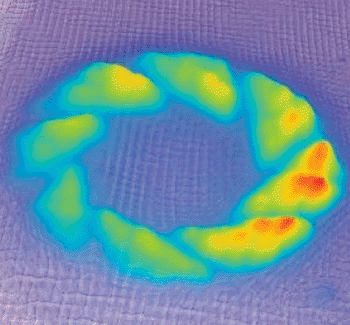Discovery Paves Way for Ultrafast High-Resolution Imaging in Real Time
By LabMedica International staff writers
Posted on 30 Apr 2013
A new research advance involving ultrafast high-resolution imaging in real time could soon become a reality.Posted on 30 Apr 2013
In research published April 16, 2013, in the journal Nature Communications, researchers from the University of Melbourne (Australia) and the University’s ARC Centre for Excellence in Coherent X-ray Science have revealed that ultrashort durations of electron bunches generated from laser-cooled atoms can be both very cold and ultrafast.

Image: A shaped group of ultrafast electrons. The pattern is meant to look like the iris shutter of a camera, invoking the concept of a fast snapshot (Photo courtesy of Andrew McCulloch).
Lead researcher Assoc. Prof. Robert Scholten reported on this astonishing finding was a significant move towards making ultrafast high-resolution electron imaging a reality. He said the finding would enhance the ability of scientists in labs to create high quality snapshots of quick alterations in biologic molecules and specimens. “Electron microscopy, which uses electrons to create an image of a specimen or biological molecule, has revolutionized science by showing us the structure at micro- and even nanometer scales,” Assoc. Prof. Scholten said. “But it is far too slow to show us critical dynamic processes, for example the folding of a protein molecule which requires time resolution of picoseconds [billionth of a billionth of a second]. “Our discovery opens up the possibility to dramatically enhance the technology.”
Researchers remarked that imaging technology at this level is like making a “molecular movie.” The temperature of the electrons determines how sharp the images can be, while the electron pulse duration has a similar effect to shutter speed. The scientists have been able to merge these two facets of speed and temperature, generating ultrafast electron pulses with cold electrons, creating opportunities for new developments in the field.
Related Links:
University of Melbourne
ARC Centre for Excellence in Coherent X-ray Science














